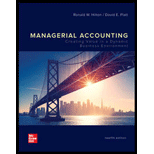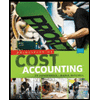
Concept explainers
Explain the primary differences between job-order and
Explain the primary difference between job-order costing and process costing.
Explanation of Solution
Job order costing: Job order costing is one of the methods of cost accounting under which cost is collected and gathered for each job, work order, or project separately. It is a system by which a factory maintains a separate record of each particular quantity of product that passes through the factory. Job order costing is used when the products produced are significantly different from each other.
Process Costing: It is a method of cost accounting used by an enterprise with processes categorised by continuous production. The cost for manufacturing those products are assigned to the manufacturing department before the averaged over units are being produced.
Explain the primary difference between job-order costing and process costing.
| Basis | Job order costing | Process costing system |
|
Work-in-process inventory Transfer of costs |
Job order costing contains one work-in-progress inventory account, along with a subsidiary ledger having individual job cost reports for each job Costs are transferred to finished goods inventory account once the jobs are completed under job order costing. |
In process costing separate work-in-process inventory account for each department or process. Costs are transferred at the end of the period to the subsequent department for additional processing and, for those products completed; costs are transferred to finishes goods inventory under process costing systems. |
Table (1)
Want to see more full solutions like this?
Chapter 4 Solutions
Managerial Accounting: Creating Value in a Dynamic Business Environment
Additional Business Textbook Solutions
Marketing: An Introduction (13th Edition)
Foundations Of Finance
Essentials of MIS (13th Edition)
Intermediate Accounting (2nd Edition)
Horngren's Accounting (12th Edition)
Gitman: Principl Manageri Finance_15 (15th Edition) (What's New in Finance)
- Sierra Tech Industries purchased an asset costing $80,000 that is expected to produce 600,000 units and have a salvage value of $8,000. In the first year, 100,000 units are produced; in the second year, 95,000 units are produced; and in the third year, 88,000 units are produced. Using the units-of-production method, what is the book value of the asset at the end of year 3?arrow_forwardWaka Company had cash sales of $78,275, credit sales of $97,450, sales returns and allowances of $1,500, and sales discounts of $4,875. Calculate Waka's net sales for this period.arrow_forwardProvide answerarrow_forward
- On 2015/1/1, Samantha Ltd. purchased machinery for $60,000. The useful life is 8 years with a salvage value of $6,000. The company uses the double declining balance method. What is the second year's annual depreciation expense (2016/12/31)?arrow_forwardBrenda Confections is preparing its cash budget and expects to have sales of $50,000 in April, $65,000 in May, and $75,000 in June. If 30% of sales are for cash, 50% are credit sales paid in the month after the sale, and 20% are credit sales paid 2 months after the sale, what are the expected cash receipts for June?arrow_forwardRK Co. sells snowboards. Each snowboard requires direct materials for $140, direct labor for $55, and variable overhead of $64. The company expects fixed overhead costs of $673,000 and fixed selling and administrative costs of $160,000 for the next year. It expects to produce and sell 11,900 snowboards in the next year. What will be the selling price per unit if RK uses a mark-up of 17% of the total cost?arrow_forward
- SP Company made sales of $32,750 million in 2019. The cost of goods sold for the year totaled $12,500 million. At the end of 2018, Malt's inventory stood at $1,300 million, and SP ended 2018 with an inventory of $1,800 million. Compute Malt's gross profit percentage and rate of inventory turnover for 2019.arrow_forwardThe company's total assets arearrow_forwardRight Answerarrow_forward
- Principles of Accounting Volume 2AccountingISBN:9781947172609Author:OpenStaxPublisher:OpenStax College
 Principles of Cost AccountingAccountingISBN:9781305087408Author:Edward J. Vanderbeck, Maria R. MitchellPublisher:Cengage Learning
Principles of Cost AccountingAccountingISBN:9781305087408Author:Edward J. Vanderbeck, Maria R. MitchellPublisher:Cengage Learning Cornerstones of Cost Management (Cornerstones Ser...AccountingISBN:9781305970663Author:Don R. Hansen, Maryanne M. MowenPublisher:Cengage Learning
Cornerstones of Cost Management (Cornerstones Ser...AccountingISBN:9781305970663Author:Don R. Hansen, Maryanne M. MowenPublisher:Cengage Learning  Managerial Accounting: The Cornerstone of Busines...AccountingISBN:9781337115773Author:Maryanne M. Mowen, Don R. Hansen, Dan L. HeitgerPublisher:Cengage Learning
Managerial Accounting: The Cornerstone of Busines...AccountingISBN:9781337115773Author:Maryanne M. Mowen, Don R. Hansen, Dan L. HeitgerPublisher:Cengage Learning College Accounting, Chapters 1-27AccountingISBN:9781337794756Author:HEINTZ, James A.Publisher:Cengage Learning,
College Accounting, Chapters 1-27AccountingISBN:9781337794756Author:HEINTZ, James A.Publisher:Cengage Learning, Managerial AccountingAccountingISBN:9781337912020Author:Carl Warren, Ph.d. Cma William B. TaylerPublisher:South-Western College Pub
Managerial AccountingAccountingISBN:9781337912020Author:Carl Warren, Ph.d. Cma William B. TaylerPublisher:South-Western College Pub





